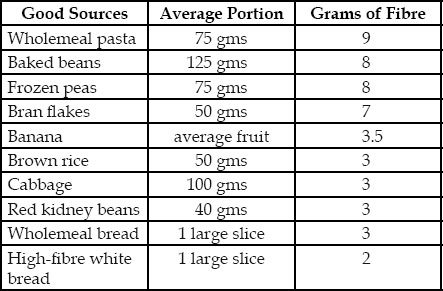

Also known as roughage, fibre is a component of food that is more or less indigestible and can be found in all fruits, vegetables and whole grains. Fibres can be either insoluble (the less digestible bran fibre) or soluble (cellulose fibres from fruits and vegetables). For good health, you need both types of fibres in your diet.
Fibre is important to your body because it helps with the proper functioning of the intestinal tract as it speeds the elimination of waste products. It is a natural laxative and alleviates constipation. Those suffering from constipation should have a rich fibre diet. In addition, a rich fibre diet prevents against colon cancer, as there is less exposure of cancer causing agents to the intestinal tract.
Individuals with diabetes may also benefit from a high fibre diet since it modulates the rate at which glucose enters the blood and prevents increases in blood levels of sugar and insulin. Soluble fibre may also help to reduce cholesterol levels. Because fibre is filling, it provides a sense of satiety with far fewer calories than fat, thus controlling obesity and hypertension. A research done by the US-based Nurses Health Study found that the risk of heart attack was significantly lower among women who consumed an average of 23 grams of fibre.
Whole grain bread and cereals; raw fruits and berries such as apples, plums, cherries, grapes, oranges, bananas, apricots, strawberries, raisins and dried fruits and vegetables such as beans, cabbage, carrot, cauliflower, celery cucumber, lettuce, onions and spinach. However, increase the fibre in your diet slowly to prevent abdominal bloating, gas and flatulence.
Most of the foods we eat such as refined flour, polished rice, milk and milk products contain little fibre. Even vegetables have relatively little fibre. Fibre rich diets reduce blood sugar, serum cholesterol and relieve constipation, besides helping in prevention and treatment of several diseases such as colon cancer and cardiovascular diseases. For a healthy diet, one needs 20 to 35 gram of fibre, every day.
 Change over to whole grains. You consume a whole variety of cereals everyday but have you ever wondered whether it is whole grain or split or broken grain? Splitting means refining the cereal and as a result the grain loses a good part of the fibre. Try to change over to whole cereals in foods such as breads, pasta, flour, buns etc.
Change over to whole grains. You consume a whole variety of cereals everyday but have you ever wondered whether it is whole grain or split or broken grain? Splitting means refining the cereal and as a result the grain loses a good part of the fibre. Try to change over to whole cereals in foods such as breads, pasta, flour, buns etc.
 Eat legumes everyday. Try and eat legumes daily, as they are one of the richest sources of fibre. Prefer whole pulses over split ones as they do not undergo much processing and hence are rich in nutrients.
Eat legumes everyday. Try and eat legumes daily, as they are one of the richest sources of fibre. Prefer whole pulses over split ones as they do not undergo much processing and hence are rich in nutrients.
 Eat a minimum of five servings of fruits and vegetables every day. Include vegetables in both lunch and dinner along with salads. This will take care of your four servings. Eat one or two fruits everyday and you can meet your five servings norm very easily.
Eat a minimum of five servings of fruits and vegetables every day. Include vegetables in both lunch and dinner along with salads. This will take care of your four servings. Eat one or two fruits everyday and you can meet your five servings norm very easily.
 Enjoy fruits and vegetables with edible peels. This not only gives you fibre but also vital nutrients that are lost along with peels. Compare for yourself– a medium potato with peel has 3.6 grams of fibre whereas the fibre content of peeled potato reduces to 2.3. Also prefer whole fruits to juices, as juice is a refined form of fruit.
Enjoy fruits and vegetables with edible peels. This not only gives you fibre but also vital nutrients that are lost along with peels. Compare for yourself– a medium potato with peel has 3.6 grams of fibre whereas the fibre content of peeled potato reduces to 2.3. Also prefer whole fruits to juices, as juice is a refined form of fruit.
 Eat a variety of foods. Variety adds not only spice to your life but also good health. You end up consuming many different types of foods and hence take in a good number of nutrients, including fibre. Besides, you eat a well-balanced diet.
Eat a variety of foods. Variety adds not only spice to your life but also good health. You end up consuming many different types of foods and hence take in a good number of nutrients, including fibre. Besides, you eat a well-balanced diet.
Certain foods like bread, rice, cereals, vegetables, fruit and nuts contain fibre. We should aim for 30 gms of fibre per day. Some of the good fibre sources are*-

